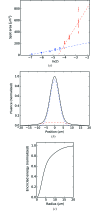Compound refractive lenses as prefocusing optics for X-ray FEL radiation
- PMID: 26917128
- PMCID: PMC4768766
- DOI: 10.1107/S1600577516001636
Compound refractive lenses as prefocusing optics for X-ray FEL radiation
Abstract
The performance of X-ray free-electron laser beamlines may be limited by the angular aperture. Compound refractive lenses (CRLs) can be employed to prefocus the X-ray beam, thereby increasing the beamline transmission. A prefocusing CRL was implemented in the X-ray transport of the Matter under Extreme Conditions Instrument at the Linac Coherent Light Source. A significant improvement in the beamline transmission was calculated over the 3-10 keV photon energy range. At 5 keV, the relative X-ray intensity was measured and a factor of four increase was seen in the beamline transmission. The X-ray focus was also determined by the ablation imprint method.
Keywords: X-ray free-electron laser; X-ray optics; compound refractive lens.
Figures




References
-
- Chalupský, J. et al. (2007). Opt. Express, 15, 6036–6043. - PubMed
-
- Chalupský, J. et al. (2010). Opt. Express, 18, 27836–27845. - PubMed
-
- Feng, Y. P., Feldkamp, J. M., Fritz, D. M., Cammarata, M., Robert, A., Caronna, C., Lemke, H. T., Zhu, D. L., Lee, S., Boutet, S., Williams, G., Tono, K., Yabashi, M. & Hastings, J. B. (2011). Proc. SPIE, 8140, 81400Q.
-
- Fletcher, L. B., Galtier, E., Heimann, P., Lee, H. J., Nagler, B., Welch, J., Zastrau, U., Hastings, J. B. & Glenzer, S. H. (2013). J. Instrum. 8, C11014.
-
- Lengeler, B., Schroer, C., Tümmler, J., Benner, B., Richwin, M., Snigirev, A., Snigireva, I. & Drakopoulos, M. (1999). J. Synchrotron Rad. 6, 1153–1167.
Publication types
LinkOut - more resources
Full Text Sources
Other Literature Sources

